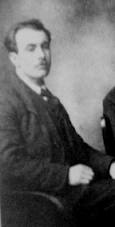Séamus Robinson (Irish republican)
Séamus Robinson (Irish: Séamus Mac Róibín; 6 January 1888 – 8 December 1961) was an Irish republican and politician.[1]
| Séamus Robinson | |
|---|---|
 | |
| Teachta Dála | |
|
In office 1921–1922 | |
| Constituency | Waterford–Tipperary East |
| Senator | |
|
In office 1928–1935 | |
| Personal details | |
| Born |
6 January 1888 Belfast, Ireland |
| Died |
6 December 1961 (aged 73) Dublin, Ireland |
| Nationality | Irish |
| Political party |
Fianna Fáil Sinn Féin |
| Spouse(s) | Brigid Keating |
Background
Born in Belfast in 1888. In 1902 he joined the First Fianna Éireann under Bulmer Hobson. In 1903 he moved to Glasgow where he joined the Gaelic League until he went to a seminary. He served as monk in Scotland in his early adulthood until he got permission in 1913 from the abbot to leave the monastery and fight in the Irish independence movement. He married Brigid Keating and had eight children.[2]
Revolutionary
1916 Rising
Robinson and his brother Joseph Robinson joined the Irish Volunteers and the Irish Republican Brotherhood in 1913 in Glasgow, and in January 1916 joined the Kimmage Garrison in Dublin. He was appointed section leader by his superior George Plunkett and participated in the Easter Rising of 1916. On Easter Monday, he marched his section to Sackville Street and was greeted by Peadar Bracken who showed him an order from Commandant James Connolly which directed him to seize Hopkins and Hopkins jeweler's on the corner of Sackville Street. He held this position under constant fire until Thursday where he directed his section across the road to the General Post Office. Remarkably, his entire section survived this perilous manoeuvre. He was then stationed in the GPO and the Metropole Hotel for the remainder of the week. He was originally sentenced to death by William Lowe for his part in the Rising, but his sentence was subsequently commuted by General John Maxwell. He was then sent to Frongach internment camp for a number of months and was released on Christmas Eve 1916.
Irish War of Independence
In 1917 Robinson came to Tipperary at the request of Eamon Uí Dubhir, whom he had met while they were both imprisoned. Robinson became active in the work of the Irish Volunteers in South Tipperary,[3] and in 1918 was elected as commanding officer of the Third Tipperary Brigade. In 1919 together with Seán Treacy, Dan Breen and Seán Hogan, he led the party which took part in an attack on a convoy transporting gelignite during the Soloheadbeg Ambush in county Tipperary on the same day that 1st Dáil met. They shot the two policemen dead and stole the explosive. This is considered to be the first engagement of the Irish War of Independence.
Following Hogan's capture in May 1919, Robinson took part in his rescue at Knocklong railway station in East Limerick while Hogan was being transported from Thurles to Cork.[4] After Knocklong, Robinson, Treacy, Breen and Hogan relocated to Dublin where they participated with Dublin volunteers in a number of attacks in the early part of the war. Robinson returned to Tipperary at the end of 1919 to resume his role commanding the Third Tipperary Brigade. Under Robinson's leadership a series of attacks on RIC barracks were undertaken by the brigade in 1920. In September 1920 he appointed Dinny Lacey as O/C of the brigade's first flying column and later that year he established the brigade's second flying column with Seán Hogan as O/C. In April 1921, he became the second in command of the IRA Second Southern Division, under Ernie O'Malley.
Civil War
At the 1921 general election, Robinson was elected to Dáil Éireann as a Sinn Féin TD for Waterford–Tipperary East.[5] He was opposed to the Anglo-Irish Treaty and voted against it. When the Irish Civil War broke out over the Treaty, Robinson sent some of his Tipperary men to help the anti-Treaty IRA fighters in Dublin, after a plea from Oscar Traynor. However, the Tipperary contingent arrived too late to take part in the Battle of Dublin. At the outbreak of civil war, he was appointed O/C of the IRA Southern Division. He was critical of the leadership of the anti-Treaty side however, saying that they had no coherent military or political strategy. He failed to win a seat at the 1922 general election.
Politics
After the Civil War, Robinson left the IRA and Sinn Féin and joined as a founding member of Fianna Fáil. Later, Robinson was elected to Seanad Éireann for Fianna Fáil in 1928 . He resigned his seat prematurely in 1935 after serving 9 years as a Senator.
Later life
In 1947 he was appointed one of the five founding members of the Bureau of Military History, associated with the history of the independence movement that lasted from 1913 to 1921 and was responsible for appointing military pensions to all those who had fought in the conflict from this period. Robinson died in Dublin on 8 December 1961 aged 72. He is survived by his two daughters.
References
- ↑ "Mr. Séamus Robinson". Oireachtas Members Database. Retrieved 26 March 2012.
- ↑ Irish Bureau of military History- Seamus Robinson's witness statement - Statement 1721
- ↑ Bureau of Military History - Witness Statement 1348 Michael Davern
- ↑ Sean Treacy and the Third Tipperary Brigade I.R.A.- Desmond Ryan -Kerryman Limited, 1945
- ↑ "Séamus Robinson". ElectionsIreland.org. Retrieved 26 March 2012.
External links
- Conflicts in Ireland: The Irish War of Independence 1919–1922
- Irish Bureau of Military History - Seamus Robinson's Witness Statement WS1721